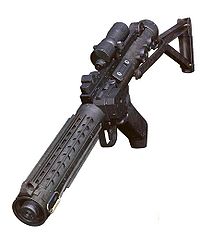Blasters
A blaster was a ranged weapon that fired bursts of particle beam energy called blaster bolts from a replaceable power pack. The most commonly used weapon in the galaxy, blasters' intense beams consisted of compacted high-energy particles and intense light that could kill or paralyze their target, depending on the setting. Blasters ranged from compact pistols, all the way up to large, heavy rifles and starship-mounted blaster cannons.
Technical information
The term blaster was often used interchangeably with the term laser in everyday conversation, both denoting the same type of particle beam weapon. However, strictly speaking, the laser was a much older weapon design than the blaster. And, unlike those of lasers, blasters' firing cycles had more proficient recharge rates, allowing them to attain a much higher rate of fire, though at a loss of range and accuracy.
There was also some dispute as to which size restrictions denoted a "blaster". For example, blasters were commonly thought of as handheld weapons only, but starship-mounted blaster cannons could fall into this category as well.
Blaster Mechanics
Blasters were a considerable improvement over the archaic laser design. Instead of a coherent beam of light, the blaster fired a compressed, focused, high-energy particle-beam that was very destructive, commonly referred to as a "bolt". The composition and characteristics of the blaster bolt could vary depending on the means used to produce it.
The less common blaster was a plasma based design, like those used by the Grand Army of the Republic. Plasma-based blasters were effective against all targets, but even more so against droids because of the nature of plasma as a superheated, ionized gas. Droids were vulnerable to ion energy, so ion weapons are a natural choice against a droid army. This explained the use of the BlasTech DC-series in the Clone wars.
In plasma-based blasters, a high-energy gas (tibanna gas, for example, used in the Blastech DC-series) would move from the gas chamber into another chamber where it was altered into a plasma state. It was then released from a magnetic "bottle" effect through the collimating components. This turned the mass of plasma gas and energy into a coherent energy beam as a coherent energy bolt of light and plasma. This combination of light and plasma formed the deadly bolt fired from a blaster. The more common type was the blaster that fired a high energy particle beam that was more deadly to humanoids and other biological targets than superheated plasma (which was quite deadly anyway), but it was still effective enough against droids to put a B1 battle droid down and keep it down. Particle-beam types were also more efficient because they used less blaster gas to produce the beam than was necessary to form a plasma bolt, as plasma, as a state of matter, required a far greater amount of energy to produce.
In particle-beam based blasters, like the E-11used, a small amount of high-energy gas moved from the Heter valve to the chamber commonly called the Xciter. In the XCiter chamber, the gas was energized by the power pack, then passed into the actuating blaster module, which, when assisted by the components in the barrel, processed the now extremely high-energy gas into a compressed beam of intense energy particles, coupled with intense light, which generated the deadly high-energy particle beam fired from most blasters. In these blasters, the combination of super hot laser-light and a compressed bolt of intense energy particles formed the deadly bolt.
